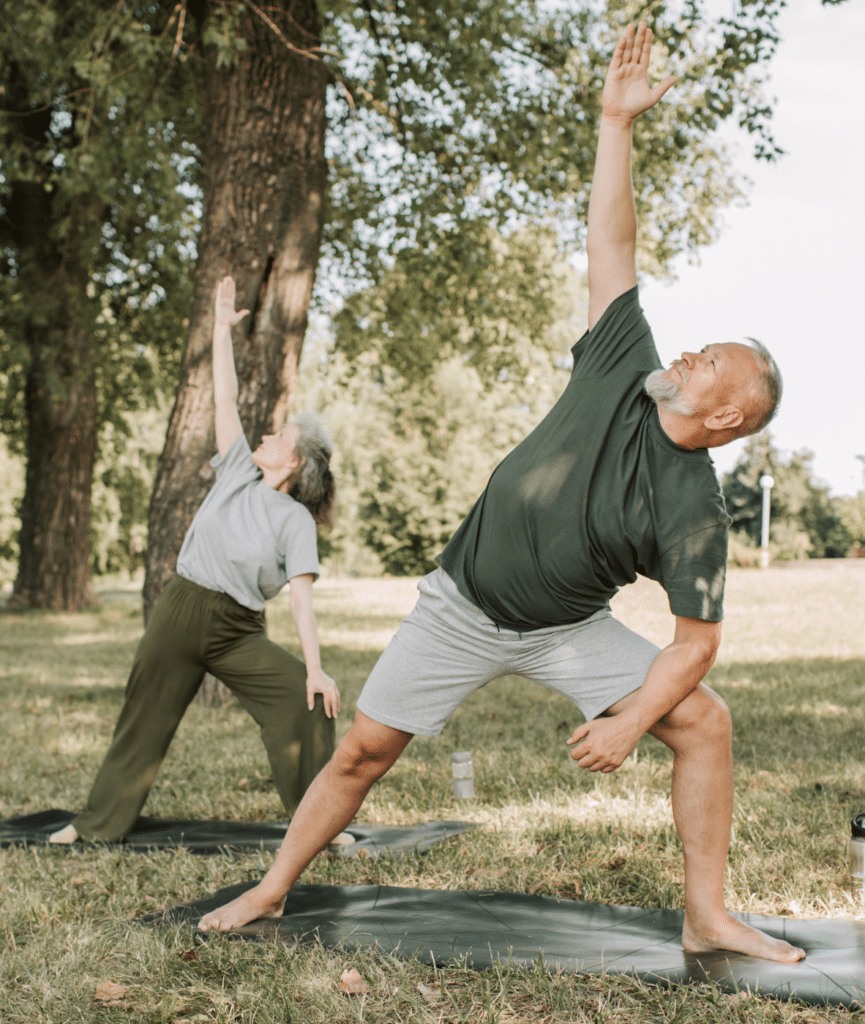Exercise and Mental Health: How Movement Can Improve Mood and Reduce Stress

Did you know there’s a natural, simple, and accessible way to lift your mood and lower your stress levels, and it could be as close as your front door? With no prescription needed and no expensive equipment?
Exercise is known for its physical benefits: improved cardiovascular health, “gains” from lifting weights, pounds shed when you run, or “before and after” progress pictures. But exercise isn’t just good for the body, it’s also a powerful tool for mental wellness. It’s why you might hear people say they’re “clear-headed” or feeling “refreshed” after a workout. Because exercise causes the release of natural, mood-boosting chemicals in the body. Sounds too good to be true? Fortunately, it’s all scientifically backed.
If you or someone you care about wants to improve their mood, reduce stress, and look after their mental wellness, you may want to know more about the benefits of exercise and how physical activity can slot into your often busy life. So let’s get moving. This article can be a useful guide as it explains;
- The science behind exercise and mental health
- Five ways exercise helps stress
- Exercise for depression and anxiety
- Tips for building a mental health-focused exercise routine
- How Mission Connection can help

Exercise for Mental Health: The Science Behind It
5 Ways Exercise Helps Stress
The following are five ways that exercise helps with stress:
1. Exercise Triggers the Release of Endorphins
Endorphins are chemicals naturally produced by the nervous system to manage pain or stress. They’re often called “feel-good” chemicals because they relieve pain and boost happiness. Endorphins are released on average after about 20 minutes of moderate intensity exercise.2
2. Exercise as a Mood Booster
Studies have shown that just 20-40 minutes of exercise can improve anxiety and mood for several hours.3 So, the good news is that if you’re feeling down, worried, or anxious, taking even a half hour of your day to get up and move will likely do the trick. Later in this article, we discuss some tips for building a simple, effective workout strategy.
3. It Reduces Stress Hormones in the Body
What is a stress hormone? It’s a chemical produced by the body in response to a stressful situation. The main stress hormone is cortisol. These natural chemicals put the body into an alert state and play a role in helping the body manage stress and repair itself. However, exposure to prolonged stress can lead to too much cortisol in the body.4
Having excess cortisol is associated with mood swings, which can lead to symptoms of depression, anxiety, and irritability. Levels of cortisol are also tightly linked to sleep quality. One study found that physical activity programmes can benefit cortisol regulation and sleep quality, with particular benefit for adults with mental health conditions. 5
4. Exercise Improves Your Self-Confidence
Self-confidence is defined by the American Psychological Association (APA) as “trust in one’s abilities, capacities, and judgment”. More simply, having confidence in yourself feels great and is a big factor in keeping a positive attitude in life.6
For example, you might succeed in an interview or do well in an exam – and for a moment you tell yourself how great you did, and how all the effort was worth it in the end. This feeling of achievement and pride is a big part of why some people exercise. By sticking to a routine, you’re effectively showing yourself that you’re capable of putting the required effort in to meet your goals. This mindset can be applied to all aspects of your life, not just in the gym.
5. It Counteracts the Effects of Negative Emotions
Exercise improves the ability of the brain to rebuild and self-adapt. This promotes the making of new connections and networks in the brain. Simply put, exercise aids in improved thinking, better mood management, and the ability to cope with stress.7 So the good news is that you can counteract the negative effects of low mood on the body and reduce stress through exercise.
Exercise for Depression and Anxiety
The following sections break down the benefits of exercise for both anxiety and depression.
The Benefits of Exercise for Depression
Depression is a common mental health
condition that can happen to anyone. People with depression have symptoms such as a low mood, hopelessness, and a loss of pleasure or interest in activities for long periods of time.8
You may already know some of the treatment options available for depression: medications such as antidepressants or various forms of talking therapy. However, lifestyle factors like exercise are also considered a key part of the discussion when it comes to a personalised treatment plan for people with depression. In fact, research has shown that exercise works much in the same way as antidepressants. Let’s break down the reasons for this effect.
The most commonly prescribed antidepressants are called “Selective Serotonin Reuptake Inhibitors”, or SSRIs for short. Serotonin is the key word here – this is the “happy chemical” released in the brain. People with depression can often have low serotonin levels, and SSRIs work by preventing the breakdown of serotonin and making it more available in the brain.
One study showed that in a group of people given exercise routines (mainly running and stretches), levels of blood serotonin were markedly increased after their workout, and symptoms of depression were decreased.9 Likewise, another study found similar results in a group of 64-year-old and above patients who were given a 16-week cardio program.10 This finding goes to show that anyone of any age can benefit from exercise. So, if you’re retired or advancing in age, exercise can still be an invaluable option for you or someone you love. Simply put, exercise has been heavily researched as a means to help people with depression, and the studies confirm its effectiveness.
The Benefits of Exercise for Anxiety
Around 4% of the world’s population experiences anxiety.11 Everyone feels scared or worried from time to time. However, people with anxiety experience these emotions in an intense and excessive way, which can result in symptoms like restlessness, irritability, and an impending sense of danger. Anxiety can even cause physical sensations such as shaking, sweating, nausea, and heart palpitations.
The most common treatment for people with anxiety is talking therapy with a mental health professional. These therapies aim to identify the root causes and possible ways to manage symptoms as they arise. Medication for anxiety is also an option, and antidepressants (such as SSRIs discussed before) are effective for some people. It’s worth noting that exercise can complement these treatments for anxiety. And the good news is that exercise is free and accessible.
The World Health Organisation (WHO) recommends exercising regularly, even if it’s just a short walk, for people with anxiety.12 Studies have shown exercise to be an efficient and cost-effective treatment alternative for anxiety.13 Research has even demonstrated that exercise may be as effective as cognitive behavioural therapy (CBT) (an evidence-based form of talking therapy), in reducing anxiety.
So, if you or someone you care about is struggling with the symptoms of anxiety or depression, be assured that while you might not always feel like it, even exercise as simple as a brisk walk can help. We’ll look at mental health fitness routines in the next section.
As a note, while the benefits of exercise for relieving symptoms of anxiety and depression are clear, they may not be enough by themselves. A holistic treatment program that incorporates therapy and lifestyle changes is often the best approach for many people.
Tips for Building a Mental Health-Focused Exercise Routine
The ideal exercise routine varies from person to person, with age being an important consideration. The World Health Organisation (WHO) provides guidance on how much exercise is suitable for different ages. This will make it easier to know what’s right for you when considering movement for mental wellness. The following tips can also help you build an exercise routine that works best for your interests and schedule.
1. Choose an Exercise You Enjoy
Start by choosing what form of exercise you’re going to do. Have fun with it and remember that exercise doesn’t have to be boring. Maybe lifting weights or running isn’t for you, and that’s okay. Ask yourself what you enjoy doing. There’s a wide range of options available for you to choose from. Swimming, soccer, tennis, badminton, basketball, hockey, and so on. Whatever brings you joy.
2. Make it a Social Activity
Do you want to work out alone or with others? It’s important to remember you don’t have to exercise alone if you don’t want to. It’s good to involve friends and family in your routine, especially if they need a boost too. Exercise can be a fun way to socialize and even meet new people. If you’re considering joining a gym, they’ll have classes where you can share your well-being journey with others. Running clubs are also increasingly popular, so it’s worth checking what’s available in your area.
3. Make it a Part of Your Routine
When should you exercise? It can be challenging to set aside time to work out, especially if you’re a parent with young kids, have loved ones who depend on you, or have a demanding job. It’s important to make your goals realistic and achievable – so pick times that are right for you. For example, if you’re too tired after work to exercise, maybe set an alarm to get up earlier and fit a 30-minute run into your routine.
Think about how often you’d like to exercise. It’s also key not to overdo it. Rest is important, so give yourself at least one day or more off, depending on how intense your exercise is. If you choose to lift weights, for instance, then rest is essential for muscle growth and recovery.
Once you have a rough idea of when and how often you want to get moving, you could draw up a timetable or plan for this in your calendar. Putting pen to paper can help you stay encouraged and motivated.
4. Track Your Progress
It’s important to track your progress. Earlier, we discussed confidence and self-esteem, and how putting in effort and achieving goals can result in a positive attitude. It makes sense to take note of all your wins and gains, so that later you can look back and really appreciate how far you’ve come. It can be as simple as “ticking off” the sessions you planned and attended. If you’d prefer to be more specific, you can use measurables such as how many kilometers you run per week or how many pounds you bench pressed at the gym. Keeping track and being able to reflect will aid you in your wellness journey.
5. Be Consistent
Remember that you’re making this routine for you, so it should be achievable and sustainable; something you see yourself doing well into the future. With this in mind, when you’ve established your exercise routine and time has passed, it’s perfectly normal to experience some exhaustion and demotivation. During times like this, it’s important not to feel disappointed or let down with yourself. Feeling like this may simply mean that your routine needs to be adjusted – it could be too strenuous, not exciting enough, or may not be meeting your needs. In short, it’s okay to experience some lows when following any long-term exercise routine – but not giving up is key. Reflect on your routine and change it, but keep going to continue seeing the many benefits of exercise for mental health.
In summary, allocate how long for and how often you want to exercise each week (which should also be an activity you enjoy doing). Even better if you can make it social and collaborate with friends or family. Set realistic and achievable targets within your means. Finally, learn from your losses, stay on track, and celebrate your wins.
Reach Out to Us For Support
We hope this article has encouraged you to see the relationship between mental health and exercise, and how it can be used as a mood booster and a powerful tool for mental wellness. For some people, exercise alone may not be enough to feel at their best. Mission Connection understands this.
Mission Connection’s multidisciplinary team can provide a range of services, including daily group therapy with licensed therapists, weekly psychiatric care with medication management, and weekly individual therapy. We can also incorporate a variety of therapeutic approaches into your personalized treatment program, such as cognitive behavioral therapy (CBT), dialectical behavioral therapy (DBT), mindfulness, psychoeducational groups, and solution-focused therapy.
Explore Mission Connections Telehealth Program:
Mission Connection proudly offers an innovative hybrid model that combines in-person and telehealth services, making it easy for you to access the care you need, no matter where you are. This way, you’re empowered to connect with your clinical team at your convenience, ensuring flexible access to care – when and how it works best for you.
Ready to prioritize your mental well-being? Mission Connection is here to help. Contact us today at 866-619-7530 for more information on how to start your journey towards healing and recovery. We’re here to support you every step of the way.

References
- Callaghan, P. (2004). Exercise: A neglected intervention in mental health care? Journal of Psychiatric and Mental Health Nursing, 11(4), 476–483. https://doi.org/10.1111/j.1365-2850.2004.00751.x
- Rafi, M. (2021). Impact of exercise on mental health: A brief overview. Science Archives, 2(1), 9–13. https://sciencearchives.org/wp-content/uploads/2021/03/Science-Archives-2021-Vol.-2-1-9-13-3.pdf
- Paluska, S. A., & Schwenk, T. L. (2000). Physical activity and mental health: Current concepts. Sports Medicine, 29(3), 167–180. https://doi.org/10.2165/00007256-200029030-00003
- American Psychological Association. (n.d.-a). Cortisol. In APA Dictionary of Psychology. https://dictionary.apa.org/cortisol
National Library of Medicine. (2022). Effects of exercise on mental health. PubMed. https://pubmed.ncbi.nlm.nih.gov/35777076/ - American Psychological Association. (n.d.-b). Self-confidence. In APA Dictionary of Psychology. https://dictionary.apa.org/self-confidence
- Smith, P. J., & Merwin, R. M. (2021). The role of exercise in management of mental health disorders: An integrative review. Annual Review of Medicine, 72, 45–62. https://doi.org/10.1146/annurev-med-042320-015847
- World Health Organization. (n.d.-a). Depression. https://www.who.int/health-topics/depression#tab=tab_1
- Wipfli, B., Rethorst, C. D., & Landers, D. M. (2011). An examination of serotonin and psychological variables in the relationship between exercise and mental health. Scandinavian Journal of Medicine & Science in Sports, 21(3), 474–481. https://doi.org/10.1111/j.1600-0838.2009.01049.x
- Melancon, M. O., Lorrain, D., & Dionne, I. J. (2014). Changes in markers of brain serotonin activity in response to chronic exercise in senior men. Applied Physiology, Nutrition, and Metabolism, 39(11), 1250–1256. https://doi.org/10.1139/apnm-2014-0074
- Global Burden of Disease (GBD) Results Tool. (2019). Global Health Data Exchange. Institute for Health Metrics and Evaluation. https://vizhub.healthdata.org/gbd-results?params=gbd-api-2019-permalink/716f37e05d94046d6a06c1194a8eb0c9
- World Health Organization. (n.d.-b). Anxiety disorders. https://www.who.int/news-room/fact-sheets/detail/anxiety-disorders
- Salmon, P. (2001). Effects of physical exercise on anxiety, depression, and sensitivity to stress: A unifying theory. Clinical Psychology Review, 21(1), 33–61. https://doi.org/10.1016/S0272-7358(99)00032-X
- McEntee, R. J., & Haglin, R. P. (1999). Cognitive group therapy and aerobic exercise in the treatment of anxiety. Journal of College Student Psychotherapy, 13(3), 37–55. https://doi.org/10.1300/J035v13n03_05
